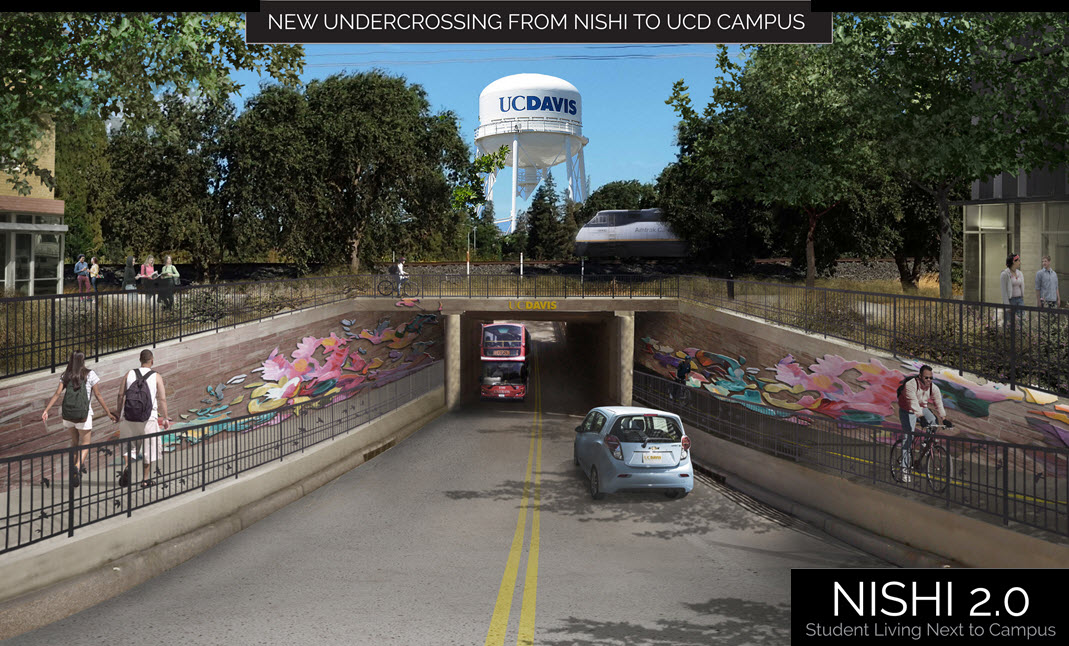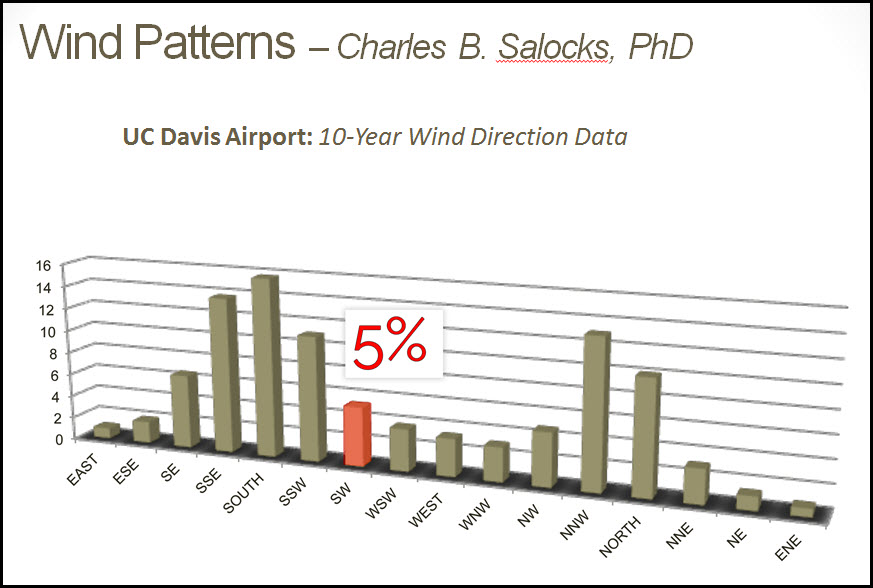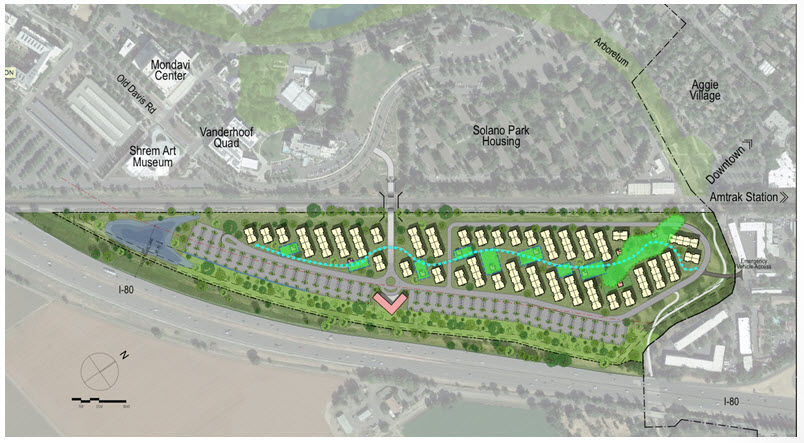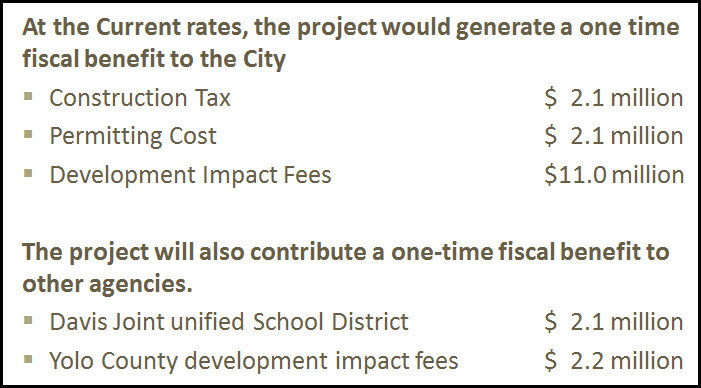

It was a long evening at the Planning Commission on Wednesday night, but ultimately the commission was unanimous in supporting the staff recommendation on Nishi to recommend to council certification of the EIR and approval of the General Plan Amendment, Prezoning and Preliminary Planned Development, Development Agreement, including provisions for affordable housing, and Baseline Project Features as required by Chapter 41 of the Davis Municipal Code.
The commission voted 7-0 on a motion, made by Stephen Mikesell and seconded by David Robertson, “to recommend that the City Council determine that the Addendum to the previously-certified EIR adequately assesses the impacts of the revised projects and there are no changed circumstances or new information requiring recirculation pursuant to Section 15164 of the State of California CEQA Guidelines.”
That was followed by a 7-0 vote on the subsequent recommendations.
In his presentation, developer Tim Ruff argued that the development team listened to the message sent by the community. Thus they: “Eliminated Private Vehicle Access to and from Richards Blvd. Eliminated other peak hour traffic generators. New undercrossing connection to UCD for bikes, pedestrians and vehicles. Focused on student housing due to the critical need, further reducing traffic trips.”
As a result they believe that there will be 2097 fewer vehicles trips every day. “Of the 2200 residents 1500 of them will NOT have a car,” they argue. “1,225 fewer parking spaces (1925 down to 700), while increasing density by 300 residents.” There will also be “700 parking spaces compared to 2300 Bike spaces.”
Unlike the last proposal, they will provide onsite affordable housing. He said that they have “[i]ntroduced a unique affordable housing program that is fully integrated serving both very low and extremely low income students, at levels never addressed before in Davis.”

“This program meets critical student housing needs adjacent to UCD,” he said. “$800,000 per year internally subsidized by developer (with) no public subsidies.”
They also had professor Charles Salocks from UC Davis analyze wind patterns. He found over a ten-year period that only five percent of the time does the wind blow particulate matter directly onto the project site.

He found, “Davis winds are variable.” There are two prevailing wind directions. Southerly winds occur about 60 percent of the time. Northerly winds occur about 40 percent of the time. However, “Worst case scenario winds (SW) occur very infrequently (5% of the time).
“Southerly and northerly winds have higher winds speeds, which cause greater dispersion of traffic-related pollutants and reduce downwind air concentrations,” Professor Salocks found. “Elevation of the freeway at Nishi enhances the dispersion of traffic-related pollutants. There are no geographic barriers to impede the dispersion of particulates. The Nishi site is not an area where they would be expected to concentrate.”
He also noted, “The health assessment in the EIR is based on an assumption of a residency of 70 years with no mitigations. (The) typical residency at Nishi will be 1-3 years, not 70. This alone reduces long-term health risk by at least 95%.”
He also found that the mitigations will further reduce exposure.
“A 100’ x 2000’ peripheral greenbelt and an internal ‘urban forest’ will filter particulates from the freeway. Future residents of Solano Park, and other nearby properties, will also benefit from this measure. Air filtration systems will further enhance indoor air quality where students spend most of their time,” the professor wrote.
He also noted that on-site auto traffic will be limited, which would reduce other exposure to particulate matter (PM) that might normally be present.
Dr. Salocks concluded: “The mitigations that will be adopted at the Nishi project are, in my opinion, comprehensive and will serve to also protect other nearby properties. This project provides a model as Davis copes with the various impacts inherent to other infill opportunities. After all, it is the utilization of such infill properties, appropriately labeled ‘smart growth,’ that are an important element of this air quality solution for everyone.”
Don Shor found that the urban trees play a huge role in reducing pollution and improving air quality by as much as 16 percent.
Among the studies cited:
- Trees planted outside the home can provide substantial reductions in PM inside the home (>50% reduction).
- A field study in Sydney, Australia, showed a 42% reduction in particulate matter from sites with more trees.
- Cahill (2008) found that redwood vegetation removed 79% of 0.17μm diameter particulate matter in a wind tunnel experiment.
- Further wind tunnel research used by Dr. Cahill estimated very high filtration of very fine particles by two species of conifers (redwood and deodar cedar), from 79 – 99%.
- As of April 2017 the state Air Resources Board now includes vegetative buffers among their recommended strategies that reduce traffic emissions.
Nishi is proposing “an urban forest with > 2000 trees and shrubs, with a goal of 85% canopy within the first few years and ultimately 100% canopy.” The parking lot will be “shaded and plant selections around the buildings will further reduce heat load and enhance pollution mitigation.”
“This 7-acre urban forest will sequester carbon as the trees grow reducing the carbon footprint of the project,” Dr. Salocks said. “It will be of benefit to the residents of Nishi, as well as Solano Park, those who work and study at UC Davis, and the community as a whole.
“The goal is to create model solutions which can be implemented anywhere communities have people living, working and playing along roadways.”

The project is projected to be 700 units with a mix of two- and three-bedroom flats. There will be 2200 residents, 700 parking spaces and 2300 bicycle parking spaces.

UC Davis Chancellor Gary May: “Housing market changes cannot be resolved by UC Davis alone. We want to continue to work cooperatively with the Davis community, City Council and other local communities to encourage smart and responsible development, drawing on the careful and innovative history of planning in the city of Davis.”
—David M. Greenwald reporting

At this point in time, I am in favor of the Nishi project. I believe that the developers have substantially addressed the issues of the opponents. I also see this as a step towards collaboration with the university and the new Chancellor which will be needed in the upcoming years in order to deal with the anticipated student housing needs in a responsible manner.
I loved Don Shor’s presentation about the particle pollution mitigation effects on Nishi and Solano Park etc. of certain types of trees and shrubs which may be planted here along with some aesthetic and bee-benefiting flowering plants, BUT I am also quite curious about Roberta Milstein’s comments about a team of UCD experts only forming now – hope I got that right, hopefully she responds – to look into air quality issues at the site.
I appreciated the information about wind effects – which was very hard to see in the image shown, by the way – but don’t understand why the main focus is only on the wind from the southwest as if the transition area on the I-80 is the only source of pollution, like a single smokestack. Sallocks’s research most certainly does not say that
but that 60% of the time it comes from the south. The I-80 is located to the south and southeast of Nishi, and I am curious if the winds here are really so similar to those at the airport, though the two locations are only a bit less than two miles apart. The airport is in an open area and the I-80 is the south and southeast of a built-up area that generates and retains heat relative to the surroundings, and doesn’t heat draw in air from cooler areas? Perhaps significantly, how does wind direction relate to time of day? What if a sort of chronic “worst case scenario” is that at peak travel times the wind comes from the southwest and south? (To be fair this could be even better if during peaks the wind comes from the north.) I am also not clear if there were any trends present in that ten-year profile.
The proposed I-80 bus/HOV lane project – if built – will also have effects on the relevant section of the freeway – all the way southwest to Kidwell Road – and from what I saw in a presentation about it there are no concrete goals about pollution reduction – or e.g. increase of transit modal share – only projections of future delay and crash reduction. This may reduce congestion temporarily, but more capacity on the freeway may induce more traffic, meaning that after a time there are more vehicles travelling on it than now.
I wrote Thomas Cahill yesterday and asked him if claims by other experts that the indoor air filtration systems will eliminate approximately 95% of ultra fine particles would be based on a system where air was continuously pumped in and filtered and re-filtered, and he seemed to agree, and he gave an example of a similar system, but one that required over-pressuring, which says to me that only do windows have to be closed, but that a fan always has to be on.
Perhaps that’s related to Community Development Administrator Katherine Hess saying quite explicitly in her introduction that there would be “trade offs” in regards to health, location and other factors.
I had planned to say the following during comments but left it out when I found out we had only two minutes to speak:
“The project is said to have risks to residents, but these are meant to mitigated by the nature of short term residency of most who will live here. The problem here is that this ignores the possibility – if not likelihood – that these short term residents will live in other polluted areas in the future, or, of course, that they have lived in polluted areas in the past. Some come from Los Angeles, others from Mexico City, others from Beijing. Going forward, it reduces their opportunities to stay healthy in other polluted places, and – if they are concerned about their own health – it lowers their future housing opportunities. Nishi – at best – creates short term problems for people who will have other short term problems in the future.”
To Me, the biggest issue is that most of the studies are baselined to 70 years. So if that is the case and you have a two to three-year exposure in the maximum, how can we say with any certainty that there is really any health risk to the students. Then on top of that you have all the mitigation measures, you have the data on wind patterns, and the trees and filtration unit. I just can’t for the life of me see that there is a real health risk here and believe this is more about stopping housing (for whatever reason) than it is about real concern for health.
Doesn’t matter, David… the “narrative is the narrative”… facts have no place in the “narrative”…
Wow.
I sort of expected more comments from others on this story and am reluctant to post once more, but so be it:
I would like to love this project. In one important aspect the location is amazing – certainly better than if similar was built on the west side of 113 due to proximity to campus and Downtown, but of course much less so due to particle emissions, as detailed in my earlier comments.
The I-80 is loud, at least subjectively (meaning that it might not be dangerous, per se). It can be heard and felt in a huge section of Davis, and is another reason for any residents of Nishi may close their windows. Don Shor said nothing about trees blocking sound. In the long-term we need to do much more about the I-80 itself, and just wait for vehicles in general to slowly go more electric.
I appreciate the small amount of low-income housing for students, but not at all that it requires these students to double up in rooms, whereas wealthier students get their own. Students improvise – sometimes against lease agreements – this elsewhere, but here that’s extremely inequitable by design: Modest rooms similar to the others should just be subsidized at at least the planned level. If the rest of the housing can be for anyone, I’m not clear why the overall 35% requirement is not being met.
As the project faces southeast and the planned buildings will be oriented to make best use of the sun, I don’t see a problem with taller buildings providing more overall capacity on the northwest where they won’t block the sun. This will further decrease VMT, particularly if the number of spaces for private non-ADA car parking is reduced to zero as suggested by Matt Williams – instead making available existing lots on campus, if private non-ADA is simply not available – just as with students who live in residence halls – or in a true satellite structure which I will describe shortly. Surface parking lots can cost about $5,000 to 10,000 per space to build, not including above-standard greenery. This means that the planned lot will cost from $3.5 to 7 million (about to 5 to 10 years of the planned on-site housing subsidy and about 2 to 4 times higher than the one-off fee to DJUSD.) At a very minimum residents should be made to follow the one permit on campus policy and not able to drive to campus.
Nishi could be a viable commercial (e.g. considerable number of offices, not just a small amount of retail)-residential project without serious negative effects on transportation. How so? (read-on).
That’s a surprisingly complicated subject, but the short answer is that trees do block sound. However, it’s the landscaping closer in to the residences that makes the most difference in that regard.
Back in 1987, my first housemate and I were sitting on the front porch, and I complained about how loud I-80 was. At the time, there was no UPRR fence, no Lexington Apartments and no freeway wall, and I-80 could be both heard and seen from the porch, about 1000′ SSW.
Phil turned to me, grinned ear-to-ear, and said, “I think it sounds like the ocean”.
Somehow, after that, the sound didn’t bother me so much.
Yeah… can be “white noise”…
We can hear UPRR/Amtrak, particularly when wind is from the south… I find it soothing… but then again, I grew up about the same distance from the SF peninsula SPRR line.